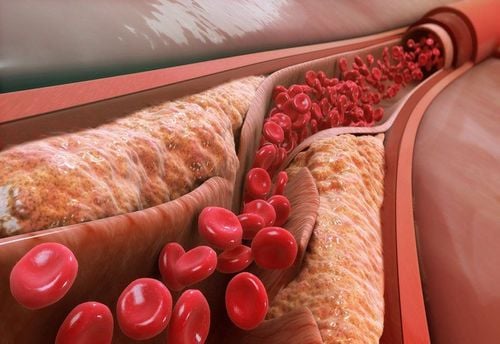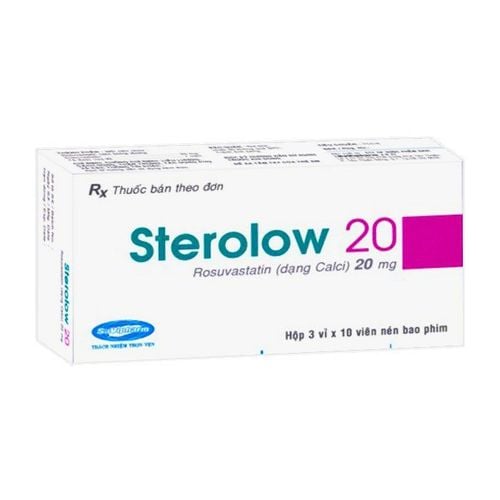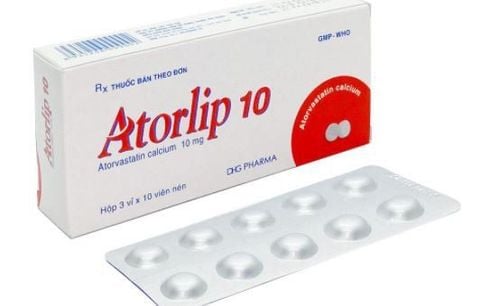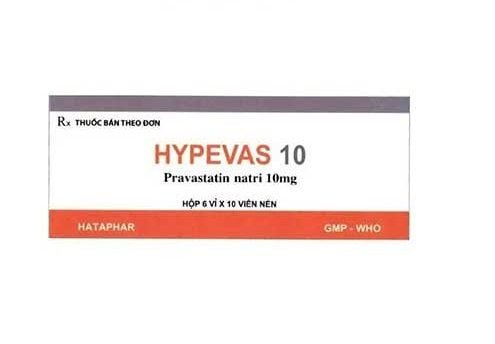This is an automatically translated article.
Vacoros drug has the main ingredient Rosuvastatin 10mg in the form of Rosuvastatin calcium, which is indicated for the treatment of homozygous familial hypercholesterolemia, dyslipidemia,... Here is some information about the drug. Vacoros helps users to use it safely and effectively.
1. What is Vacoros?
Vacoros is a drug belonging to the group of cardiovascular drugs. Vacoros is prepared in the form of film-coated tablets, packed in boxes of 10 blisters x 10 tablets, 50 blisters x 10 tablets, 100 blisters x 10 tablets; box of 5 blisters x 20 tablets, 10 blisters x 20 tablets, 50 blisters x 20 tablets and packed in bottles of 100 tablets, 200 tablets, 500 tablets, 1000 tablets.
Vacoros drug has the main ingredient Rosuvastatin 10mg and some other excipients, just enough for 1 tablet.
2. What are the uses of Vacoros?
Vacoros is indicated for the treatment of patients in the following cases:
Vacoros is used to treat primary hypercholesterolemia, mixed dyslipidemia (type llB), homozygous familial hypercholesterolemia death. The case of patients with dyslipidemia Use of Vacoros for primary prevention of cardiovascular events diabetes. Use of Vacoros treatment to reduce the progression of coronary atherosclerosis.
3. Dosage - How to take Vacoros
3.1. How to use Vacoros drug is prepared in the form of film-coated tablets, which are tolerated in the body orally.
Should take the drug in the evening, follow a low cholesterol diet before taking Rosuvastatin and must continue to maintain this diet throughout the treatment.
3.2. Dosage Vacoros dose depends on each subject and the course of the disease, there will be an appropriate dose. Below is the dose of Vacoros for reference as follows:
The starting dose of the drug is 5mg or 10mg Vacoros/day. Drink once a day. If necessary, the patient can adjust the dose after every 4 weeks of using Vacoros. The dose of the drug at 40mg Vacoros/day is only used when severe hypercholesterolemia at high risk of cardiovascular disease does not reach the treatment goal at the dose of 20mg Vacoros/day, patients need to be monitored regularly.
Care should be taken when using Vacoros in patients with predisposing factors for rhabdomyolysis such as hypothyroidism, renal failure, alcoholics, personal or family history of hereditary muscle diseases, history of toxicity on muscle due to other HMG-CoA reductase inhibitors or Fibrates, over 70 years of age, conditions causing increased drug levels in the blood, concomitant use of Fibratem.
Discontinue Vacoros if CK > 5 x ULN or severe muscle symptoms. Should not be used in the presence of infections, hypotension, major surgery, trauma, electrolyte disturbances, endocrine, severe metabolism such as: Uncontrollable convulsions.
4. In what cases is Vacoros not used?
Below are some cases where patients should not use Vacoros drug to treat diseases such as:
Vacoros drug should not be used for patients with hypersensitivity or history of allergy to Rosuvastatin and other excipients that may contain active ingredients. in medicine. Do not use in patients with developed liver disease including unexplained persistent elevations in serum transaminases, and when transaminases are elevated more than 3 times the upper limit of normal. Vacoros should not be used in patients with severe renal impairment. Do not use Vacoros for patients with myopathy. Do not use Vacoros for patients who are taking Cyclosporin. Do not use Vacoros for pregnant women: Because the drug can harm an unborn baby while in the mother's womb. Therefore, it is contraindicated to use the drug during pregnancy. Lactation: Rosuvastatin is distributed into breast milk. Therefore, the use of Vacoros in breast-feeding is not recommended.
5. Notes when using Vacoros treatment
Here are some notes when using Vacoros treatment.
Vacoros contains color excipients, which can cause allergies. The drug contains lactose, caution should be exercised in patients with galactose intolerance, lactase deficiency or glucose-galactose malabsorption. Before and during treatment with the drug, the patient should have an appropriate diet, exercise and weight loss regimen to control blood cholesterol. It is necessary to conduct periodic lipid measurements and adjust the dose of Vacoros according to the patient's response to the drug. Severe or fatal rhabdomyolysis has been reported with statin use. Vacoros should be used with caution in patients at high risk of skeletal muscle toxicity such as: People with impaired renal function, hypothyroidism, the elderly, and users in combination with muscle toxic drugs to help diagnose myopathy in humans. The latter has side effects. During the course of taking Vacoros, the patient develops diffuse myalgia, muscle weakness or pain, and the serum CK concentration is 10 times higher than the normal limit. The patient needs to stop treatment with Vacoros. If myalgia is not moderately elevated in serum CK or does not increase, the patient should be monitored weekly until symptoms improve, if symptoms worsen, the drug should be discontinued. Patients with acute and severe myopathy or risk factors for acute renal failure due to rhabdomyolysis (eg, severe acute infection, hypotension, metabolic, endocrine, electrolyte, or contraction abnormalities) uncontrolled convulsions,...) need to temporarily stop or stop him taking the drug. Vacoros should only be used in women of childbearing age when it is certain that the patient is not pregnant and only in cases of very high blood cholesterol that has not responded to other drugs.
6. Vacoros . side effects
During the use of Vacoros, patients may experience some unwanted side effects such as:
Common:
Digestive: Diarrhea, constipation, abdominal pain, flatulence and nausea. CNS: Headache, insomnia, dizziness, blurred vision, weakness. Neuro-musculoskeletal: Muscle and joint pain. Liver: Liver function test results increased to more than 3 times the upper limit of normal, but were usually reversible upon discontinuation of Vacoros treatment. Uncommon:
Neuromuscular and skeletal: Myopathy, muscle weakness, increased plasma creatinine phosphokinase levels. Skin: Skin rash. Respiratory: HO, rhinitis, pharyngitis, sinusitis. Rare:
Central nervous system disorders: Cognitive impairment. Neuro-muscular and skeletal: Myositis, rhabdomyolysis, acute renal failure secondary to myoglobinuria. Endocrine: Increases HbA1c and fasting serum glucose levels, increasing the risk of developing diabetes. Using the drug for driving and operating machinery can cause headaches, blurred vision, dizziness.
7. Vacoros drug interactions
Limit the combination of Vacoros with other lipid-lowering agents, because of the potential for increased risk of myopathy. Care should be taken when administering Vacoros with angiotensin-converting enzyme inhibitors, calcium channel blockers, beta-blockers, diuretics and non-steroidal anti-inflammatory drugs. Antacids such as aluminum hydroxide and magnesium hydroxide administered concomitantly with Vacoros will reduce peak plasma concentrations and AUC of rosuvastain. It should be taken 2 hours after taking Vacoros. Fluconazole: Co-administration of Vacoros at a single dose of 80 mg/day and fluconazole (200 mg/day for 11 days) may increase peak plasma concentrations and AUC of Vacoros by 9% and 14%, respectively. Itraconazole: Co-administration of Vacoros at a single dose of 10 mg rosuvastatin/day and itraconazole (200 mg/day for 5 days): increased peak plasma concentrations and AUC of rosuvastatin by 36% and 39%, respectively. Co-administration of 80 mg rosuvastatin/day (single dose) and itraconazole (200 mg/day for 5 days): increased peak plasma concentrations and AUC of rosuvastatin by 15% and 28%, respectively. Ketoconazole: Concomitant administration of Vacoros at a single dose of 80 mg/day and ketoconazole (200 mg twice daily for 7 days): decreased peak plasma concentrations of rosuvastatin by 5% and increased rosuvastatin AUC by 5%. 2%. Cyclosporin: Concomitant use with Vacoros increases the risk of myopathy. Digoxin: Co-administration of 40 mg rosuvastatin/day for 12 days and digoxin at a single dose of 0.5 mg/day may increase the peak plasma concentration and AUC of digoxin by 4%. Erythromycin: Co-administration of 80 mg rosuvastatin/day (single dose) and erythromycin (500 mg 4 times/day for 7 days) may reduce peak plasma concentrations and AUC of rosuvastatin by 31% and 20%, respectively. Concomitant use of fenofibra and rosuvastatin increases the risk of myopathy. Concomitant use with gemfibrozil and rosuvastatin may increase the risk of myopathy. Atacamavir and Lopinavir Ritonavir when used concomitantly with rosuvastatin increases the risk of myopathy. If co-administration of these drugs is required, the dose of rosuvastatin should be reduced and a maximum dose of 10 mg rosuvastatin/day used. A physician should be consulted when using concomitantly Fosamprenavir, Tipranavir and rosuvastatin. Concomitant use of rosuvastatin and niacin increases the risk of myopathy. If it has to be used at the same time, the patient must consult a doctor/pharmacist. Oral contraceptives: concomitant use of rosuvastatin 40mg/day for 28 days and oral contraceptives (ethinyl estradiol 0.035mg/day with norgestrel 0.18mg, 0.215mg and 0.25mg/day for 21 days): increased peak plasma concentrations and AUC of ethinyl estradiol by 25% and 26%, respectively; of norgestrel were 23% and 34%, respectively. Avoid co-administration of rosuvastatin with grapefruit juice as there may be an increased risk of muscle toxicity when simvastatin and lovastatin concentrations are elevated. Vacoros may increase the effects of warfarin. The above are the main uses of the drug Vacoros, before using it, patients need to carefully consult and follow the instructions of a professional doctor to get the best treatment results.













